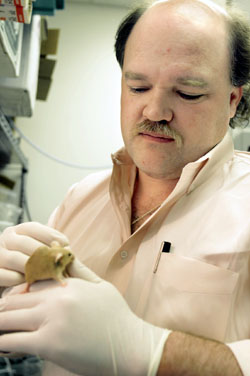
Bob Kesterson, Ph.D., holds a special mouse which lacks a certain receptor that plays a role in feeding responses and anxiety. (photo by Dana Johnson)
Investigators uncover functions of stress-activated receptors
Stress starts in your head — in the hypothalamus, deep inside the brain, stress activates the release of the substance corticotropin-releasing hormone (Crh). Several groups of investigators reported this month what happens when mice are missing one of the receptors for Crh. They discovered that the Crh type 2 receptor plays roles in cardiovascular regulation, feeding responses, and anxiety.
Crh receptors may be good targets for drugs to combat the effects of stress.
"An entire company (Neurocrine Biosciences) was founded to look at stress and anxiety and Crh receptors, with an eye to developing drugs directed at these receptors," said Robert A. Kesterson Jr., Ph.D., assistant professor of Molecular Physiology and Biophysics, who generated and evaluated Crh type 2 receptor knockout mice in collaboration with a group at the Oregon Health Sciences University. Their findings, and those of two other groups, are reported in three papers this month in Nature Genetics.
Crh sits atop the stress signaling mountain. In response to Crh, the pituitary gland releases hormones that travel in the bloodstream to the adrenal gland and stimulate the production and release of steroids.
Kesterson, whose laboratory focuses on the neurobiology of feeding behavior, was primarily interested in how Crh and another similar substance called urocortin work to regulate food intake. It was known that both Crh and urocortin, when injected into mice, potently inhibit feeding. Other researchers reported that knocking out the Crh type 1 receptor does not alter feeding responses, suggesting that the type 2 receptor was responsible for Crh and urocortin's effects on feeding.
"We predicted that if there is a chronic Crh or urocortin signal that inhibits feeding, then mice without the Crh type 2 receptor — whose cells could no longer respond to the signal — would become obese," Kesterson said. "But they didn't."
The mice do have differences in their feeding responses to urocortin. Urocortin still inhibits feeding in the knockout mice, but they bounce back and begin eating sooner than normal mice do. These data suggest that the Crh type 2 receptor is needed for the long-lasting effects of urocortin on feeding behavior, Kesterson said.
"Because feeding is such a basic mechanism for survival, we shouldn't be surprised that this may be just one of possibly hundreds of genes that modulate feeding behavior," he said. "The question really is, under what conditions do these different feeding pathways get activated?"
That is a question that Kesterson and his colleagues will seek to answer, using the Crh type 2 receptor knockout mice and other knockout mice that they have generated.
Crh and urocortin both work in the brain to send signals that increase heart rate. Out in the blood vessels, they cause dilation, which lowers blood pressure. The Crh type 2 receptor knockout mice have elevated blood pressure all the time, suggesting that this receptor normally contributes to blood pressure maintenance, Kesterson said.
"Mutations in the gene for the Crh type 2 receptor could very well be linked to cardiovascular problems in human beings," he said. "We don't know the normal circumstances for the Crh type 2 receptor to be called into action to regulate heart rate or blood pressure. We're just now defining the biology."
The other two papers in Nature Genetics focus mainly on anxiety and the stress response. They find, using a variety of behavioral tests, that the Crh type 2 receptor knockout mice are more anxious than normal mice. In contrast, mice lacking the Crh type 1 receptor are less anxious than normal mice: they were reported as being "laid-back mice."
"For anxiety and feeding, it appears that the Crh type 1 and 2 receptors work together to shape the response," Kesterson said. "That is important information for ongoing drug development programs."
"The recent findings provide extremely useful models to understand the complexities of the biological response to both physical and emotional stressors."
Kesterson's collaborators at the Oregon Health Sciences University include Sarah C. Coste and Mary P. Stenzel-Poore. The work was supported by the National Institutes of Health.













